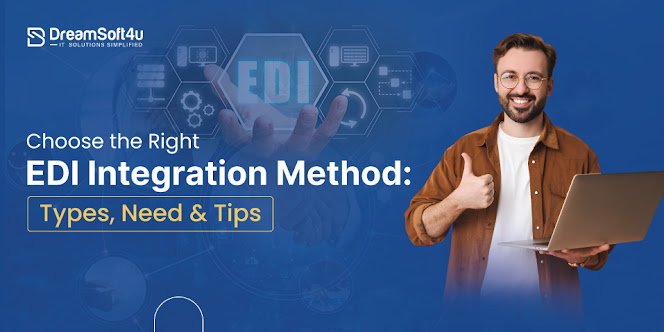How to Pick the Right EDI Integration Method? Types, Need & Tips
As today’s market is changing dynamically, businesses need to stay competitive and up-to-date. One of the most important tools that meets business needs is the Electronic Data Interchange (EDI) tool. It helps businesses collaborate and optimize operations. Various industries, such as retailers and manufacturing, often use the EDI Integration Method to exchange data between two parties in a standard way with more efficiency. Now, EDI usage is expanding in different industries and becoming a crucial role in data transactions.
According to the stats, the EDI software market is expected to reach $4.52 billion by 2030 with a CAGR of 12.5% because it automates most of the data exchange operations and eliminates the paperwork needed. However, many businesses are not aware of the role of EDI integration and its benefits.
What is EDI?
EDI stands for Electronic Data Interchange, it’s a standard system that allows businesses to exchange important documents electronically in a standard and secured format. Some of the documents include invoices, loan application agreements, purchase orders, and shipment forms. The main aim of the EDI system is to reduce the time, human effort, and paperwork to share a document with another business, just by sending it electronically. It’s a great alternative to traditional data exchanging methods and most of the industries now use EDI systems rather than paper-based data.
5 Important Elements of EDI
Flexible Communication
Easy Data Management
Automatic Translation
Effective Mapping
Seamless Integration
What is EDI Integration?
EDI integration is a process of integrating the EDI system with other systems. For example – EDI systems integrate with warehouse, transportation, back-office, or ERP systems. It can help businesses across different industries streamline their data exchange operations and reduce time and manual error chances. It helps businesses stay competitive, improve their operations, and make decisions better. Businesses have both options, where to develop an EDI system or integrate the best EDI system from EDI service providers.
What are the Stages for Integrating EDI?
Meeting the Requirements
Checking ERP Compatibility
Deciding Actions
Extracting Data
Data Mapping
Testing Notifications
Going Live
Key Advantages of EDI Integration
Here are some key EDI benefits:
It minimizes the manual work of data entry
It saves cost by eliminating the paper-work
It improves communication and relationships with partners.
It improves the order-to-cash cycle.
It reduces the human error chances by automating most of the operations.
It can easily integrate with other systems to make the data exchange process efficient and streamlined.
Types of EDI Solutions For Your Business
If you want to find the right EDI solution then it’s quite challenging. Because there are various types of size EDI solutions available. So, let’s break and help you choose the best type of EDI for your business needs:
1. On-premise vs. Cloud-based
Cloud-based EDI: In this case, the host uploads the documents on cloud servers which can be easily accessible online. However, the vendor has more control over storing, managing, and updating the data.
On-premise EDI: In this type, businesses prefer to install EDI on their servers to get complete control over updating and managing data while sharing with other partners.
2. Managed vs. Unmanaged
Managed EDI: Managed EDI will take care of everything including data mapping, setting up connections with trading partners, and ongoing management. It’s an ideal option for those businesses who have lots of complex documents to share.
Unmanaged EDI: Unmanaged EDI requires manual operations to handle all the aspects. It’s a preferred option for those who have resources but find it challenging to utilize for management.
3. Web-based EDI
Web-based EDI is a cost-effective option for small businesses that want to exchange over 200 documents in a month with less than five trading partners. So, the process isn’t complex and easily set up and is good to go. Plus, it allows you to easily view and manage EDIT data directly through a web interface.
Key Requirements for EDI Integration
To successfully integrate the EDI system into your business, here are some key requirements to consider:
Number of Trading Partners: First, identify how many trading partners you exchange data with. Because it will determine the complexity of setting up EDI.
Volume of Transactions: The amount of EDI transactions you will handle also requires the EDI capacity you need.
Resources and Technical Skills: The amount of EDI transactions you will handle also requires the EDI capacity you need.
Budget: What’s your budget for an EDI solution is one of the key factors to consider
Trading Partner Preferences: Also, identify your trading partner’s preference and compatibility.
Three Methods of Integration
There are three main ways to implement EDI integration. However, each method has its benefits and drawbacks. Let’s find out the best EDI integration method:
1. Direct EDI Integration
In this method, you can directly connect your EDI system with a trading partner’s system. Which gives you high speed and control but can be costly to set up and complex to maintain.
2. Value-Added Networks (VANs)
This method handles the EDI communication between firms by the middlemen. Which ensures security, and dependability and facilitates communication without direct connection.
3. AS2 (Applicability Statement 2)
AS2 is a widely used protocol that allows EDI communication over the internet. Which guarantees secure data transport and ensures digital encryption. Various sectors like retailers and healthcare are using AS2 for safe transactions.
Source: https://www.dreamsoft4u.com/choose-the-right-edi-integration-method-types-need-and-tips




Comments
Post a Comment